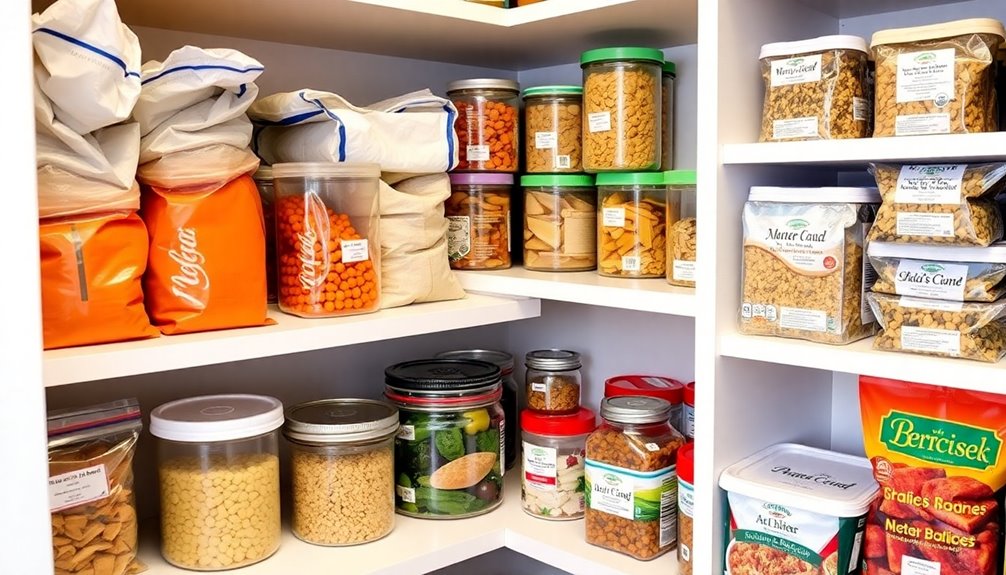You're entering a world where luxury and survival converge, where high-net-worth individuals invest millions in opulent underground bunkers and shelters. Companies like Vivos and Rising S cater to super-rich preppers with price tags ranging from $40,000 to several million dollars. These luxury shelters offer unparalleled comfort and security, complete with pools, movie theaters, and gourmet dining. Fear of the unknown, climate change, and economic collapse anxiety drive demand for these exclusive hideouts. As you explore this world, you'll uncover the motivations and preparedness of wealthy survivalists, and the critiques surrounding their extreme measures – and discover the true cost of ultimate security.
Key Takeaways
- High-net-worth individuals invest in luxury bunkers for extended self-sufficiency, with price tags ranging from $40,000 to several million dollars.
- Luxury survival shelters offer high-end amenities like pools, movie theaters, and gourmet dining to provide a sense of normalcy and comfort.
- Wealthy survivalists prepare for natural disasters, economic collapse, and societal unrest with extreme measures like luxury bunkers and escape plans.
- Self-sustaining eco-systems in bunkers ensure access to clean drinking water and reduce reliance on external grids with air-purifying plants and renewable energy sources.
- Critics argue that wealthy survivalists prioritize personal escape over sustainability, exacerbating social inequalities and undermining community resilience.
The Rise of Luxury Survivalism
As the world becomes increasingly uncertain, you're not alone in wondering what the wealthy are doing to prepare for the worst. The answer lies in the rise of luxury survivalism, where high-net-worth individuals are investing heavily in opulent bunkers and state-of-the-art security measures.
This growing trend has led to a surge in demand for underground shelters that offer more than just basic survival amenities. Companies like Vivos and Rising S are catering to the super-rich preppers, providing ultra-luxury bunker options with price tags ranging from $40,000 to several million dollars. These luxury survival shelters are designed to provide self-sufficiency for extended periods, offering a combination of security, comfort, and survival amenities.
As you explore further into the world of luxury survivalism, you'll discover that these underground havens are equipped with everything from pools to games and dining options, making them feel more like luxurious retreats than doomsday bunkers. With the wealthy investing heavily in these underground sanctuaries, it's clear that luxury survivalism is more than just a trend – it's a way of life.
Billionaire Bunkers and Secret Shelters

As you explore the world of billionaire bunkers and secret shelters, you'll discover luxury underground retreats that offer a safe haven from the outside world. These elite survival sanctuaries, such as Europa 1 in Germany, provide a high level of comfort and security, complete with self-contained village amenities and customized options to suit individual needs.
With prices ranging from $40,000 to $14 million, these exclusive hideaways cater to the ultra-wealthy who are willing to invest in their survival and comfort.
Luxury Underground Retreats
What drives you to invest in a luxury underground retreat, where self-sufficiency and secrecy come at a hefty price tag?
For those who can afford it, luxurious bunkers like Europa 1 in Germany offer over 2500 sq ft of living space with self-contained village amenities. Rising S Company shelters provide customized options, starting from basic shelters at $40,000 to luxury series ranging from $3.78 million to $14 million.
If you're looking for a more affordable option, Vivos Europa 1 in South Dakota, USA, designed for independent living for a year, offers a 99-year lease for $1,090 a year with a $55,000 upfront deposit.
However, security concerns have been raised about the viability of closed ecosystems within bunkers and their ability to withstand unknown threats. Despite this, applications for luxury underground retreats like Vivos and Rising S shelters start at $35,000 and $40,000 respectively, with discounts for survival skills and multi-million dollar options available.
Are you willing to pay the price for peace of mind in a luxurious underground retreat?
Elite Survival Sanctuaries
You're likely wondering what the ultra-wealthy have in store for themselves when the going gets tough, and that's where elite survival sanctuaries come in – the ultimate billionaire bunkers and secret shelters that redefine luxury and exclusivity. These underground bunkers offer a level of comfort and security that's unparalleled, with Europa 1 in Germany boasting over 2500 sq ft of living space and self-contained village amenities.
Rising S Company shelters, on the other hand, provide customized options for wealthy clientele, with basic options starting at $40,000 and luxury series ranging from $3.78 million to $14 million. For those looking for a more affordable option, Vivos Europa 1 in South Dakota, USA, offers a 99-year lease for $1,090 a year with a $55,000 upfront deposit, designed for independent living for a year.
While security concerns surround the viability of closed ecosystems in bunkers, the allure of these elite survival sanctuaries is undeniable, especially during times of global uncertainty. Applications have surged during global events, with online prices starting at $35,000 and discounts offered for individuals with survival skills.
Apocalypse Chic: Luxury Amenities

In the event of a global catastrophe, luxury bunkers are designed to provide a level of comfort and normalcy, complete with high-end amenities that cater to the needs of the super-rich preppers. You'll find underground facilities equipped with pools, movie theaters, and gourmet dining to make you feel like you're still living the high life, even in the face of Armageddon.
| Luxury Amenities | Description | Location |
|---|---|---|
| Pools | Relaxation and recreation | Luxury bunkers |
| Movie Theaters | Entertainment and relaxation | Survival condos in Kansas |
| Gourmet Dining | Fine dining experience | High-end bunkers |
| Gyms and Spas | Fitness and wellness | Elite survival sanctuaries |
These luxury amenities are designed to provide a sense of normalcy and comfort, even in the most extreme scenarios. With high-tech security systems, high-speed internet, and luxurious furnishings, you'll be able to survive in style. Whether you're looking for dog parks, medical facilities, or classrooms, these underground shelters have got you covered. The focus is on providing a comfortable post-apocalyptic lifestyle, where you can thrive even in the darkest of times.
Fear of the Unknown Drives Demand

As you consider the motivations behind the wealthy's fascination with luxury bunkers, you're likely wondering what drives their desire for secure shelters and survival preparations.
The answer lies in their fear of the unknown, as uncertain times ahead, global chaos concerns, and economic collapse anxiety all contribute to their readiness to invest in survival strategies.
Uncertain Times Ahead
Fear of the unknown is driving the super-rich to prepare for the worst, fueling a growing demand for luxury survival solutions that can guarantee their safety and comfort in uncertain times. You're likely wondering what's behind this trend. The answer lies in the looming threats of climate change, which poses significant risks to global stability and security.
As the consequences of rising temperatures and extreme weather events become more apparent, the super-rich are taking proactive measures to secure their survival and maintain their luxurious lifestyle, even in the face of catastrophic disasters.
You might assume that their concerns are exaggerated, but the reality is that the super-rich are keenly aware of the challenges they'll face in acquiring necessities post-disaster. They're investing in secure locations and shelter options, focusing on self-sufficiency and independence during crises.
Global Chaos Concerns
You're driven to prepare for the worst-case scenario when the unknown looms large, and for the super-rich, that means investing in luxury survival solutions that guarantee their safety and comfort in the face of global chaos.
The fear of the unknown is a powerful motivator, and concerns about global chaos, societal collapse, and unpredictable threats are driving demand for secure bunkers and survival preparations.
As uncertainty about the future and potential calamities grows, so does the desire for exclusive, fortified shelters among the super-rich preppers. These high-end bunkers, often equipped with luxury amenities, advanced security systems, and sustainable resources, promise to protect their occupants from a wide range of threats, from natural disasters to societal collapse. Top American preppers have been leading the charge, influencing demand for secluded, self-sufficient properties that can withstand even the most extreme scenarios. In many cases, these shelters are disguised as lavish homes or retreats, ensuring privacy while providing peace of mind.
The fear of chaos and breakdown of societal structures compels wealthy individuals to seek refuge in secure, well-equipped bunkers to safeguard survival. It's not just about having a safe haven; it's about maintaining a sense of control and normalcy in the face of uncertainty.
For the super-rich, investing in luxury survival solutions is a way to mitigate the risks associated with global chaos, and it's an investment they're willing to make to ensure their safety and comfort.
Economic Collapse Anxiety
Uncertainty about the future of the global economy fuels your concerns about financial instability, driving demand for luxury survival solutions that can safeguard your wealth and well-being in the event of an economic collapse.
As a high-net-worth individual, you're not immune to the fear of the unknown, and the prospect of financial instability keeps you up at night. The anxiety of an economic collapse is a major driver of demand for luxury bunkers and high-end security measures. You're willing to invest heavily in survival preparations to insulate yourself from potential economic disasters.
Your concerns aren't unfounded, as the threat of societal breakdown and economic turmoil looms large. The desire to secure your wealth and well-being in times of crisis is a primal urge, and you're willing to spare no expense to guarantee your safety and comfort. Luxury survival solutions offer a sense of security and control in an uncertain world, and you're willing to pay top dollar for that peace of mind.
Underground Oases for the Elite

Among the affluent, a new breed of underground oases has emerged, offering a luxurious refuge from the uncertainties of the world above. You'll find opulent bunkers like Europa 1 in Germany, providing over 2500 sq ft of living space, complete with self-contained village amenities.
Rising S Company shelters offer customized options for the wealthy, ranging from basic models at $40,000 to luxury series priced from $3.78 million to $14 million. For a more affordable option, Vivos Europa 1 in South Dakota, USA, designed for independent living for a year, offers a 99-year lease for $1,090 a year with a $55,000 deposit upfront.
These underground oases boast closed ecosystems, promising a secure haven from the outside world. However, concerns arise regarding the viability of these systems, and doubts persist about their ability to withstand unknown threats. As you consider investing in these elite bunkers, you'll want to weigh the benefits against the risks and uncertainties of relying on a closed ecosystem.
Survival of the Richest Mindset

Explore the provocative concept of the 'Survival of the Richest' mindset, where tech billionaires' escape fantasies are laid bare, exposing the arrogance and hubris that fuels their elite status. You'll investigate the world of transhumanism, an elite religion that prioritizes personal escape over sustainable living. This mindset is critiqued in a book authored by a self-proclaimed Marxist, who sheds light on the disconnect between the wealthy and ordinary citizens. The book emphasizes the need for collective action and local community involvement to address sustainability challenges, rather than relying on individual escape plans.
As you read on, you'll discover how the 'Survival of the Richest' mindset perpetuates the notion that only the wealthy can survive catastrophic events. This ideology is problematic, as it neglects the well-being of the majority and focuses solely on the interests of the elite.
Readers praise the book for its thought-provoking content and the necessity of raising awareness about the impact of billionaires on the world. By understanding the 'Survival of the Richest' mindset, you'll gain insight into the motivations and values of the wealthy, and the need for a more collective approach to addressing global challenges.
Preparing for the Worst-Case Scenario

As you explore the world of wealthy survivalists, you're struck by the extreme measures they're taking to prepare for the worst-case scenario, from luxury bunkers to elaborate escape plans. These high-net-worth individuals aren't taking any chances, and their preparations often revolve around ensuring their safety and security in the face of catastrophic events.
For instance, many Silicon Valley moguls are investing in state-of-the-art bunkers and secure shelter options, designed to withstand natural disasters, economic collapse, or even societal unrest. Their focus is on the aftermath of such events, where resources may be scarce and survival uncertain.
To that end, they're acquiring motorcycles for quick escapes, stockpiling essential supplies, and even undergoing medical procedures, like Reddit's CEO Steve Huffman, who'd eye surgery to improve his chances of survival. By taking these drastic measures, wealthy preppers are betting on their ability to ride out the storm and emerge stronger on the other side.
The Cost of Ultimate Security

Your ticket to ultimate security comes with a hefty price tag, ranging from a modest $40,000 for basic shelters to a staggering $14 million for ultra-luxury facilities.
If you're looking for a more exclusive experience, Vivos Europa 1 in Germany offers living spaces at a cost of $5 million per person, complete with over 2500 sq ft and self-contained village amenities.
On the other hand, Rising S Company customizes shelters with features like shooting ranges and crypto mining rooms, with basic options starting at $40,000.
For a more affordable option, Vivos Europa 1 in South Dakota provides modest accommodations for independent living for a year with a 99-year lease at $1,090 a year and a $55,000 upfront deposit.
These elite bunkers are more than just bomb shelters; they're self-sustaining communities designed to keep you safe and comfortable during catastrophic events.
With prices starting at $35,000 and discounts for individuals with survival skills, it's no wonder applications surged during global events.
Whether you're looking for luxury or simplicity, there's a survival solution tailored to your budget and needs.
Isolated From the Apocalypse

As you consider isolating yourself from the apocalypse, you'll want to think about the type of shelter that can provide a safe haven.
Bunkers and safe houses, equipped with self-sustaining eco-systems, are a popular choice among wealthy survivalists, offering a chance to ride out catastrophic events in comfort.
Bunkers and Safe Houses
You can retreat to luxurious bunkers and safe houses, designed to keep you comfortable and isolated from the apocalypse. These underground havens offer a range of amenities to guarantee your comfort during a crisis. From pools and games to fine dining, you'll be living in style while the world above falls apart.
Here's a glimpse into what you can expect from these luxury bunkers:
| Feature | Description |
|---|---|
| Price | $40,000 to millions, depending on customization |
| Amenities | Pools, games, dining, and more |
| Design | Self-contained villages with independent living |
| Applications | Surge during global events, with discounts for survival skills |
| Concerns | Viability of closed ecosystems and unknown threats |
While these bunkers promise a life of luxury, concerns have been raised about their ability to withstand unknown or unprecedented threats. As you consider investing in a bunker, it's crucial to weigh the pros and cons and think critically about your survival strategy. Will you be prepared for the apocalypse in style and comfort? The choice is yours.
Self-Sustaining Eco-Systems
These self-sustaining eco-systems, meticulously designed to thrive in isolation, are the backbone of billionaire bunkers, guaranteeing long-term survival without reliance on external resources.
You're probably wondering what makes these eco-systems so unique. Here's a glimpse into the features that set them apart:
- Hydroponic gardens: Providing a vital supply of fresh produce, these gardens are an essential component of the bunker's food source.
- Aquaponics: A closed-loop system that combines fish farming with hydroponics, creating a sustainable food source.
- Air filtration: Advanced systems that purify the air, removing toxins and maintaining a healthy environment.
- Renewable energy sources: Solar panels, wind turbines, and other eco-friendly solutions power the bunker, reducing reliance on external energy grids.
- Water purification systems: Advanced technology that guarantees access to clean drinking water, even in the most uncertain times.
These self-sustaining eco-systems are designed to function independently, allowing you to survive in isolation for extended periods.
The Dark Side of Wealthy Survivalism

As you explore deeper into the world of wealthy survivalism, you'll uncover a more disturbing reality – the dark side of this phenomenon.
One of the most unsettling aspects of wealthy survivalism is its tendency to foster elitist attitudes, prioritizing individual escape over collective well-being. Critics argue that, in the face of environmental collapse, wealthy survivalists are more concerned with saving themselves than addressing the broader sustainability issues that affect us all.
This raises questions about the ethical implications of prioritizing individual survival over collective well-being in the face of global crises.
By focusing on personal escape fantasies, wealthy survivalists often disconnect from the realities faced by the general population during times of disaster. This disconnect can exacerbate social inequalities and undermine community resilience in times of crisis.
As you explore this world, you'll realize that the dark side of wealthy survivalism highlights a glaring lack of accountability towards society.
Frequently Asked Questions
What Celebrities Have a Doomsday Bunker?
You're wondering which celebrities have a doomsday bunker? Well, Kanye West reportedly owns one in Wyoming, and rumors suggest Meryl Streep, Peter Thiel, and Kim Kardashian are also invested in underground bunkers for security.
How Much Does It Cost to Build a Doomsday Bunker?
You're wondering how much it costs to build a doomsday bunker? Well, prices vary wildly – from $40,000 for basic options to $14 million for luxury series, depending on features and amenities you want to include.
What Is Inside the Lives of the Super Rich?
You're curious about the lives of the super rich, where luxury meets paranoia. They invest in security, debate safe havens, and prep for doomsday, all while questioning their extreme success and mortality.
What Is the Show About Underground Bunkers?
You're about to uncover a secret world where the ultra-rich prep for doomsday in style! The show about underground bunkers takes you on a journey to luxurious shelters with pools, games, and gourmet dining, revealing the ultimate in survival luxury.
Conclusion
As you explore the world of super rich preppers, you'll uncover a fascinating statistic: 50% of Silicon Valley entrepreneurs are actively securing for a catastrophic event.
This growing trend raises questions about the motivations and consequences of luxury survivalism. From billionaire bunkers to apocalypse chic, the wealthy elite are investing heavily in their own private doomsday plans.
Will their preparations guarantee their survival, or will they ultimately exacerbate the very problems they're trying to escape?










